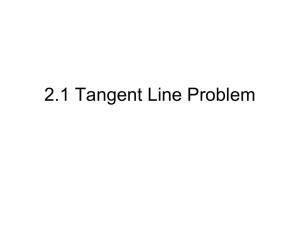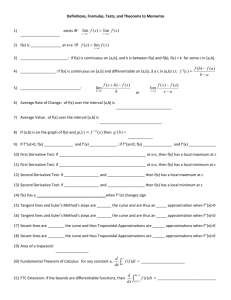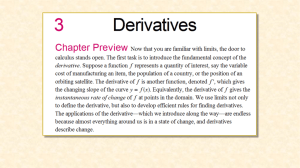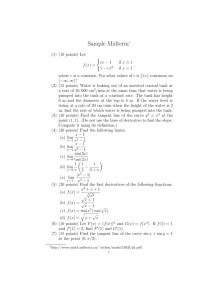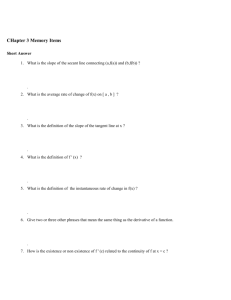Derivatives of Polynomials
advertisement
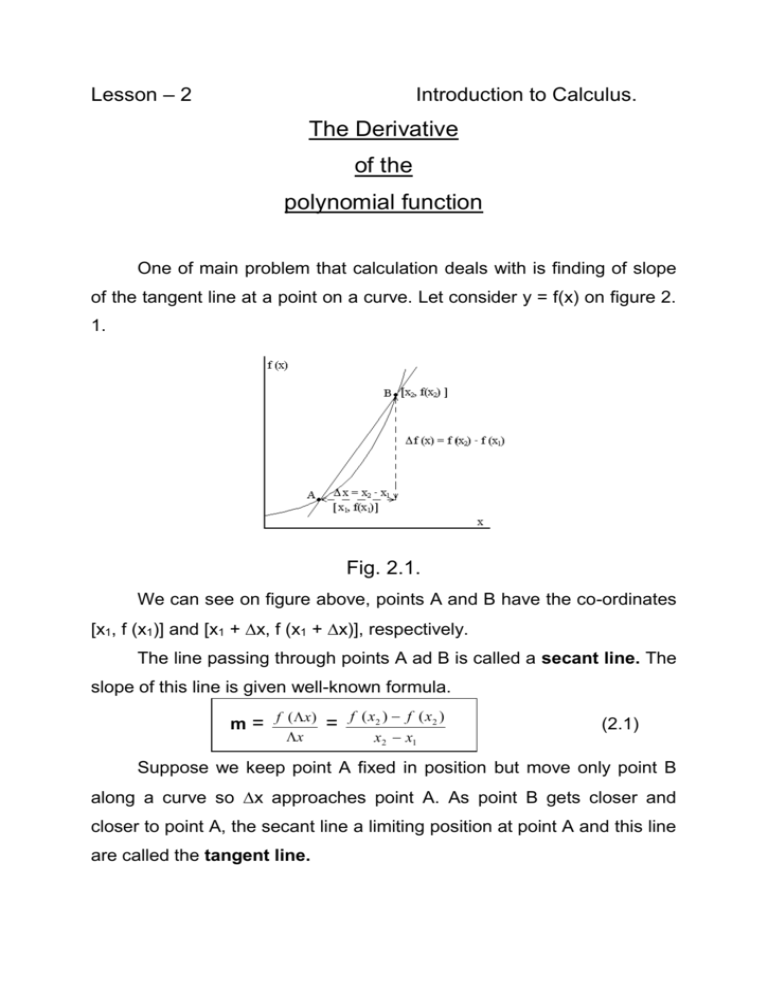
Lesson – 2 Introduction to Calculus. The Derivative of the polynomial function One of main problem that calculation deals with is finding of slope of the tangent line at a point on a curve. Let consider y = f(x) on figure 2. 1. Fig. 2.1. We can see on figure above, points A and B have the co-ordinates [x1, f (x1)] and [x1 + x, f (x1 + x)], respectively. The line passing through points A ad B is called a secant line. The slope of this line is given well-known formula. f ( x2 ) f ( x2 ) m = f ( x ) = x x2 x1 (2.1) Suppose we keep point A fixed in position but move only point B along a curve so x approaches point A. As point B gets closer and closer to point A, the secant line a limiting position at point A and this line are called the tangent line. Now, since the tangent line is a limiting position of secant lines, we consider the slope of the tangent line to a limiting value of the slopes of secant lines A-B as point B approaches point A. This occurs when x approaches 0 and is seen in Fig. 2. 2. Fig. 2. 2. We may say that the slope of a curve y = f(x) at point [x1, f(x1)] point A) is given by the limit: m= lim x 0 f ( x ) = x lim x 0 f ( x1 x) f ( x1 ) x We can make this result apply to any points [x, f (x)] on curves just by replacing x1 with x. These give us: lim x 0 f ( x1 x) f ( x1 ) x (2. 2) This limit is basis of the differential calculus and is called the derivative of f (x) with respect to x and is denoted as f’ of x, or called d [ f ( x)] dx (dee f(x), dee x) or dy (dee y, dee x) dx This process of finding derivatives is called differentiations. Obtaining derivatives of functions using the formula, we called obtaining derivatives from the first principle. Remember: dy y but dx x y lim x x 0 Example 1. If f (x) = x2 – 2x, find derivative f’ (x) from the first principle. Solution: For the function f (x) = x2 – 2x the f (x + x) is determined as: f (x) = x2 – 2x then difference quotient is equal to: 2 2 y = f ( x x) f ( x) = ( x x) 2( x x) ( x 2 x) x x x as (x+ x)2 = x2 + 2xx + x (from known formula (m + n)2 = m2 + 2mn + n2 then: 2 2 2 2 y = x 2 xx (x) 2 x 2 x 2x x 2 x = 2 xx x 2x x x x After factoring x from nominator and cancelling, we obtain: y = x(2 x x 2) = 2x + x – 2 x x To get the derivative, we take the limits as x → 0. To doing this we, treat x as a constant because it is x that is changing. f’ (x) = dy = dx lim (2 x x 2) = 2x – 2 x 0 Example 2. If y = 4 , find dy from the first principle. x dx Solution: If y = f x) = 4 , then difference quotient is equal to: x 4 x ( x x)4 4 4 y = f ( x x) f ( x) = x x x = x( x x) = x x x x = 4 x 4 x 4 x = x ( x x ) x 4x 4 4 = =x( x x)x x( x x) x( x x) Thus, F’(x) = dy = dx lim 4 x( x x) = - 42 x x 0 Rules for differentiation to Remember 1. If f (x) = C then f’ (x) = 0 2. If f (x) = xn then f’ (x) = nxn – 1 3. If g (x) = C*f (x), g’(x) = C*f’(x) 4. If f (x) = g (x) ± h (x) then f’(x) = g’(x) ± h’(x) Example 3. Find datives following functions: a) y = x4 Solution: y’= 4x3 b) y = 5/4x(5/4 – 1) Solution: y’ = 5/4(5/4-1)x(5/4-1 – 1) = 5/4(1/4)x(5/4- 2) = 5/16x-3/4 c) y = x-6 Solution: y’ = -6x(-6 – 1) = -6x-7 d) s = 31 t Solution: We must write s as a power of t. So s = t-1/3 s’ = -1/3 t-1/3- 1 = -1/3t-4/3 = -1/3t-4/3 = -1/3 1 = -1/3 31 = 3 t4 t t =-1/3t-4/3 e) y = -6t-3 Solution: y’= -6(-3)t(-3 – 1) = 18t-4 f) 1 = 18 t 4 = 184 t y = -6x3 – 2x2 + 7x – 8 Solution: y’= -6(3)x2 –2(2)x + 7x1 – 1 –0 = -18x2-4x + 7x0 = -18x2 –4x + 7 g) f (h) = 5h(h2 – 6), find f’ (2) Solution: f’ (h) = 15h2 – 30h and f’ (2) = 60 – 30 = 30 EXERCISES: Differentiate following functions: 1. f (x) = 5 2. f (x) = 26 3. y = x6 4. f (x) = x21 5. y = x80 6. y = x6.1 7. f (x) = 9x2 8. y = 4x4 9. g (w) = 4w2 10. v (x) = 2x3 11. y = 2/3x4 12. f (p) = 3 p4 13. 9 f (t) = t 14. 3 y= x 15. f (x) = x + 3 16. f (x) = 3x – 2 18 3 17. f (x) = 3x2 –2x + 3 18. f (x) = 7x2 – 5x 19. g (p) = p4 – 3p3 – 1 20. f (t) = -13t2 + 14t + 1 21. y = x-8 + x5 22. y = -8x4 + 6 23. y = -13x3 + 14x2 –2x + 3 24. V (r) = r8 –r6 + 3r2 + 1 25. h (x) = 4x4 + x3 –9/2x2 +9x 26. f (x) = -3x2 + 9/2x + 2 27. f(x) = 3/2x4 7/3x3 28. p (x) = x7/7 + 2/3x 29. f (x) = x7/2 30. f (x) = 2x-14/5 31. y = x3/4 32. y = -9x1/3 + 5x-2/5 33. y=x 34. y = -x-2/3 35. f (r) = 6 3 r 36. 8 y = 4x x 37. f (x) = x-4 38. f (s) = 3s-2 39. f (x) = x-3 + x-5 – 2x-6 40. f (x) = 100x-3 + 10x1/2 41. y = 17 42. y = 23 43. y = 15 44. y = 15 x x x 4x Answers: 1. 0 6. 2. 6x5 0 3. 6.1x5.1 7. 18x 10. 6x2 11. 8/3x3 14. x2 15. 1 16. 19. 4p3 – 9p4 20. -26t + 14 23. -39x2 + 28x – 2 24. 26. -6x + 9/2 30. 4. 21x20 5. 80x79 8. 16x3 9. 20w4 12. 4 3 p3 3 17. 6x – 2 21. -8x-9 + 5x4 22. 8r7 –42r5 + 6r 13. 25. 1/2t8 18. 28. x6 + 2/3 -28/5x-19/5 31. 3/4x-1/4 32. -3x-2/3 –2x-7/5 33. 1/2x-1/2 34. 2/3x-1/3 35. 2r-2/3 37. -4x-5 38. -6s-3 39. -3x-4 – 5x-6 + 12x-7 40. -300x-4 + 5x-1/2 41. -7x-8 42. -32x3 16x3 + 3x2 9x + 9 6x3 + 7x2 27. 14x – 5 29. 36. 6x-4 43. 7/2x5/2 1/2x-7/8 -15x-6 44. -5/4x-6
